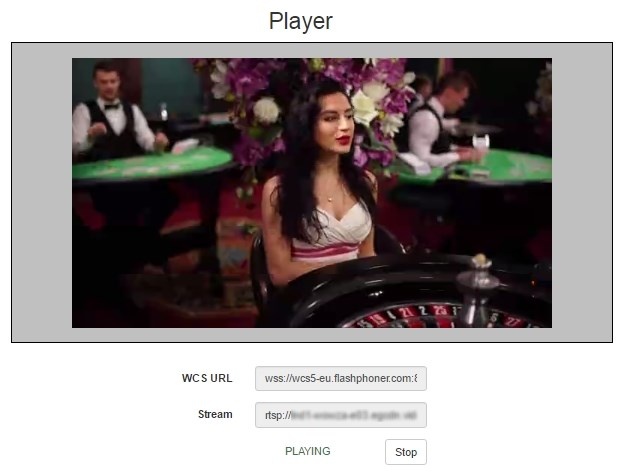Player example
This player can be used to play any type of stream on Web Call Server
- RTSP
- WebRTC
- RTMP
- RTMFP
- SIP
On the screenshot below an RTSP stream is being playing in the web player.
Code of the example
The path to the source code of the example on WCS server is:
/usr/local/FlashphonerWebCallServer/client2/examples/demo/streaming/player
player.css - file with styles
player.html - page of the player
player.js - script providing functionality for the player
This example can be tested using the following address:
https://host:8888/client2/examples/demo/streaming/player/player.html
Here host is the address of the WCS server.
Work with code of the player
To analyze the code, let's take the version of file player.js with hash cf0daabc6b86e21d5a2f9e4605366c8b7f0d27eb, which is available here and can be
downloaded with corresponding build 0.3.18.1894.
1. Initialization of the API.
Flashphoner.init() code
Flashphoner.init({flashMediaProviderSwfLocation: '../../../../media-provider.swf'});
2. Connection to server
Flashphoner.createSession() code
Flashphoner.createSession({urlServer: url}).on(SESSION_STATUS.ESTABLISHED, function(session){
setStatus(session.status());
//session connected, start playback
playStream(session);
}).on(SESSION_STATUS.DISCONNECTED, function(){
setStatus(SESSION_STATUS.DISCONNECTED);
onStopped();
}).on(SESSION_STATUS.FAILED, function(){
setStatus(SESSION_STATUS.FAILED);
onStopped();
});
3. Receiving the event confirming successful connection
ConnectionStatusEvent ESTABLISHED code
Flashphoner.createSession({urlServer: url}).on(SESSION_STATUS.ESTABLISHED, function(session){
setStatus(session.status());
//session connected, start playback
playStream(session);
}).on(SESSION_STATUS.DISCONNECTED, function(){
...
}).on(SESSION_STATUS.FAILED, function(){
...
});
4. Playback of video stream.
session.createStream(), play() code
When stream is created, the following parameters are passed
- streamName - name of the stream (rtsp:// address in this case)
- remoteVideo - <div> element, in which the video will be displayed
session.createStream({
name: streamName,
display: remoteVideo
...
}).play();
5. Receiving the event confirming successful stream playback
StreamStatusEvent PLAYING code
session.createStream({
name: streamName,
display: remoteVideo
}).on(STREAM_STATUS.PLAYING, function(stream) {
document.getElementById(stream.id()).addEventListener('resize', function(event){
resizeVideo(event.target);
});
setStatus(stream.status());
onStarted(stream);
}).on(STREAM_STATUS.STOPPED, function() {
...
}).on(STREAM_STATUS.FAILED, function() {
...
}).play();
6. Stop of playback.
stream.stop() code
function onStarted(stream) {
$("#playBtn").text("Stop").off('click').click(function(){
$(this).prop('disabled', true);
stream.stop();
}).prop('disabled', false);
}
7. Receiving the event confirming successful stream playback stop
StreamStatusEvent STOPPED code
session.createStream({
name: streamName,
display: remoteVideo
}).on(STREAM_STATUS.PLAYING, function(stream) {
...
}).on(STREAM_STATUS.STOPPED, function() {
setStatus(STREAM_STATUS.STOPPED);
onStopped();
}).on(STREAM_STATUS.FAILED, function() {
...
}).play();
